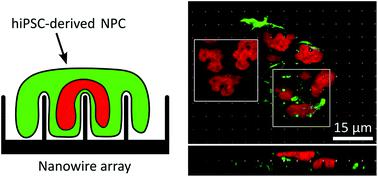Our official English website, www.x-mol.net, welcomes your feedback! (Note: you will need to create a separate account there.)
Culturing human iPSC-derived neural progenitor cells on nanowire arrays: mapping the impact of nanowire length and array pitch on proliferation, viability, and membrane deformation
Nanoscale ( IF 6.7 ) Pub Date : 2021-11-29 , DOI: 10.1039/d1nr04352h Jann Harberts 1 , Katja Bours 1 , Malte Siegmund 1 , Carina Hedrich 1 , Michael Glatza 2 , Hans R Schöler 2 , Undine Haferkamp 3 , Ole Pless 3 , Robert Zierold 1 , Robert H Blick 1, 4
Nanoscale ( IF 6.7 ) Pub Date : 2021-11-29 , DOI: 10.1039/d1nr04352h Jann Harberts 1 , Katja Bours 1 , Malte Siegmund 1 , Carina Hedrich 1 , Michael Glatza 2 , Hans R Schöler 2 , Undine Haferkamp 3 , Ole Pless 3 , Robert Zierold 1 , Robert H Blick 1, 4
Affiliation

|
Nanowire arrays used as cell culture substrates build a potent tool for advanced biological applications such as cargo delivery and biosensing. The unique topography of nanowire arrays, however, renders them a challenging growth environment for cells and explains why only basic cell lines have been employed in existing studies. Here, we present the culturing of human induced pluripotent stem cell-derived neural progenitor cells on rectangularly arranged nanowire arrays: In detail, we mapped the impact on proliferation, viability, and topography-induced membrane deformation across a multitude of array pitches (1, 3, 5, 10 μm) and nanowire lengths (1.5, 3, 5 μm). Against the intuitive expectation, a reduced proliferation was found on the arrays with the smallest array pitch of 1 μm and long NWs. Typically, cells settle in a fakir-like state on such densely-spaced nanowires and thus experience no substantial stress caused by nanowires indenting the cell membrane. However, imaging of F-actin showed a distinct reorganization of the cytoskeleton along the nanowire tips in the case of small array pitches interfering with regular proliferation. For larger pitches, the cell numbers depend on the NW lengths but proliferation generally continued although heavy deformations of the cell membrane were observed caused by the encapsulation of the nanowires. Moreover, we noticed a strong interaction of the nanowires with the nucleus in terms of squeezing and indenting. Remarkably, the cell viability is maintained at about 85% despite the massive deformation of the cells. Considering the enormous potential of human induced stem cells to study neurodegenerative diseases and the high cellular viability combined with a strong interaction with nanowire arrays, we believe that our results pave the way to apply nanowire arrays to human stem cells for future applications in stem cell research and regenerative medicine.
中文翻译:

在纳米线阵列上培养人类 iPSC 衍生的神经祖细胞:绘制纳米线长度和阵列间距对增殖、活力和膜变形的影响
用作细胞培养基质的纳米线阵列为先进的生物应用(如货物输送和生物传感)构建了一个强大的工具。然而,纳米线阵列的独特形貌使它们成为具有挑战性的细胞生长环境,并解释了为什么在现有研究中只使用基本细胞系。在这里,我们展示了在矩形排列的纳米线阵列上培养人类诱导多能干细胞衍生的神经祖细胞:详细地,我们绘制了大量阵列间距对增殖、活力和地形诱导的膜变形的影响(1, 3, 5, 10 μm)和纳米线长度(1.5, 3, 5 μm)。与直觉预期相反,在具有 1 μm 最小阵列间距和长 NW 的阵列上发现扩散减少。通常,细胞在这种密集间隔的纳米线上以类似 fakir 的状态沉降,因此不会受到纳米线使细胞膜缩进造成的实质性压力。然而,在小阵列间距干扰正常增殖的情况下,F-肌动蛋白的成像显示沿着纳米线尖端的细胞骨架的明显重组。对于较大的间距,细胞数量取决于 NW 长度,但尽管观察到由纳米线封装引起的细胞膜严重变形,但增殖通常会继续。此外,我们注意到纳米线与核在挤压和缩进方面的强烈相互作用。值得注意的是,尽管细胞发生了大量变形,但细胞活力仍保持在 85% 左右。
更新日期:2021-11-29
中文翻译:

在纳米线阵列上培养人类 iPSC 衍生的神经祖细胞:绘制纳米线长度和阵列间距对增殖、活力和膜变形的影响
用作细胞培养基质的纳米线阵列为先进的生物应用(如货物输送和生物传感)构建了一个强大的工具。然而,纳米线阵列的独特形貌使它们成为具有挑战性的细胞生长环境,并解释了为什么在现有研究中只使用基本细胞系。在这里,我们展示了在矩形排列的纳米线阵列上培养人类诱导多能干细胞衍生的神经祖细胞:详细地,我们绘制了大量阵列间距对增殖、活力和地形诱导的膜变形的影响(1, 3, 5, 10 μm)和纳米线长度(1.5, 3, 5 μm)。与直觉预期相反,在具有 1 μm 最小阵列间距和长 NW 的阵列上发现扩散减少。通常,细胞在这种密集间隔的纳米线上以类似 fakir 的状态沉降,因此不会受到纳米线使细胞膜缩进造成的实质性压力。然而,在小阵列间距干扰正常增殖的情况下,F-肌动蛋白的成像显示沿着纳米线尖端的细胞骨架的明显重组。对于较大的间距,细胞数量取决于 NW 长度,但尽管观察到由纳米线封装引起的细胞膜严重变形,但增殖通常会继续。此外,我们注意到纳米线与核在挤压和缩进方面的强烈相互作用。值得注意的是,尽管细胞发生了大量变形,但细胞活力仍保持在 85% 左右。


























 京公网安备 11010802027423号
京公网安备 11010802027423号